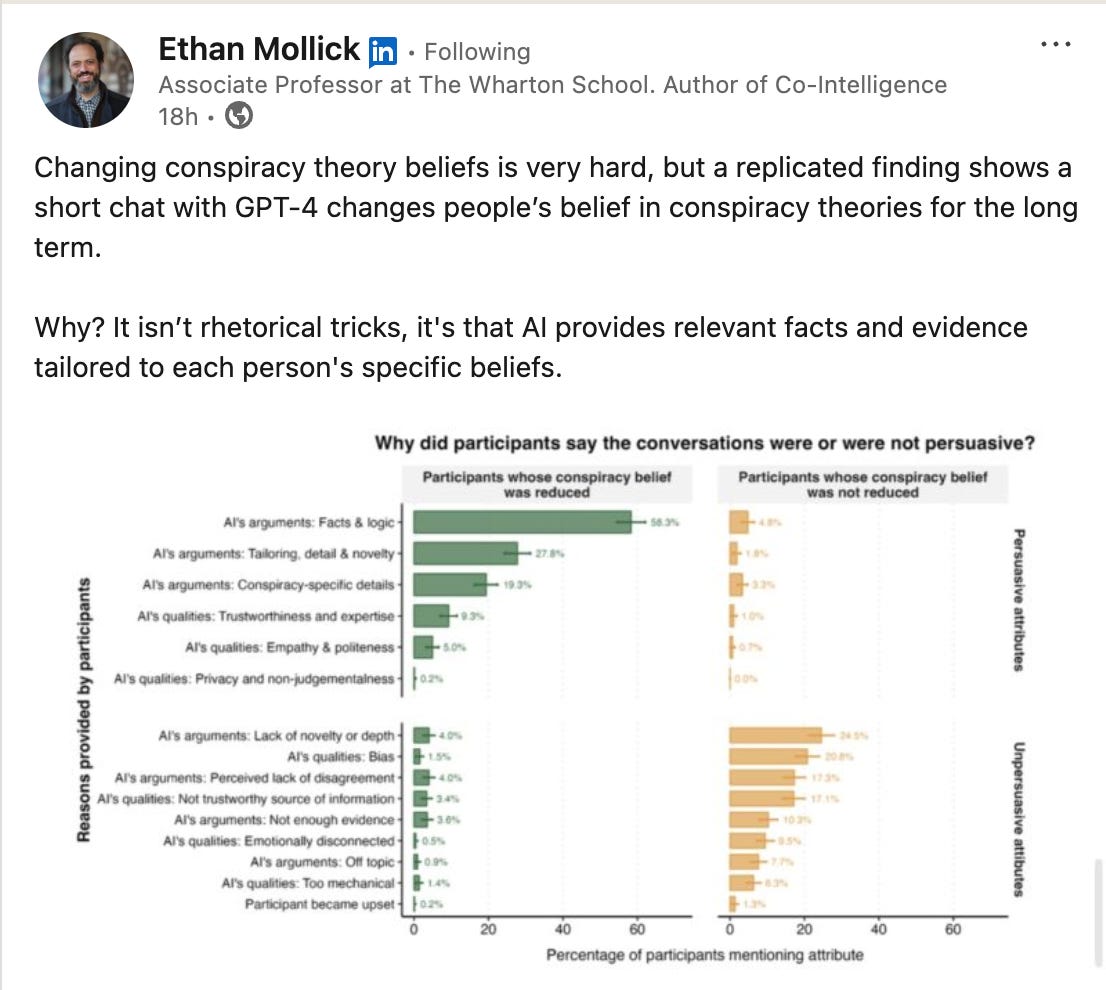Using Conversational AI to Explore Nuanced Perspectives
Beyond Echo Chambers: Using AI to Explore Complex Global Narratives
I often wish that I could gather instant feedback from a range of nuanced voices, all in one place. That’s exactly what I stumbled upon recently with Societies.io—an AI-powered app that connects to your social accounts. You write a post, send it off, and almost magically receive suggestions from AI-generated persona versions of your connections. Around the same time, I came across a post by Ethan Mollick describing how GPT-4 can subtly yet powerfully influence people’s deeply held beliefs through interactive, persuasive conversations.

These two experiences sparked an idea: If AI can shift social media perspectives, why not harness its power to help students explore current events from multiple nuanced angles? By guiding them through simulated dialogues with AI “personas,” we can encourage critical thinking, empathy, and an appreciation for nuance and complexity .
The Concept: AI Personas as Windows to Nuanced Viewpoints
Students use a Large Language Model, like ChatGPT or Claude, to generate nuanced opinions based on different perspectives surrounding a real-world event. For example, consider the war in Ukraine—a conflict that has become a defining global issue. The aim is not to promote a particular standpoint, but rather to illuminate the complex narratives that often escape our usual sources of information. Through these AI personas, students can engage with a multitude of voices, from Ukrainian citizens and Russian perspectives to international journalists and peace advocates, all offering unique viewpoints.
Why is this Useful?
A robust understanding of varied nuanced perspectives empowers students to build more complex mental models of current events that lead to productive critical thinking. In the War in Ukraine example, it highlights:
Challenging Preconceptions: Students compare and contrast responses from AI personas reflecting Ukrainian citizens, Russian viewpoints, and global observers, discovering how media narratives and cultural backgrounds shape opinions.
Encouraging Nuanced Dialogue: When AI-generated personas present well-researched yet diverse viewpoints, students learn about the conflict’s causes, consequences, and possible resolutions.
Fostering Critical Thinking: We equip students to question biases, scrutinize evidence, and appreciate the human toll behind political rhetoric—skills that are invaluable in a media-saturated world.
Sample Prompts for AI-Generated Personas
If you’re curious about how this might look in practice, here are some sample prompts designed to elicit balanced, fact-based responses:
A Persona from Ukraine
“You are a Ukrainian citizen living in a region deeply affected by the war. Describe, in factual and personal terms, how the conflict has reshaped your community, your hopes for peace, and the challenges you face daily.”
A Persona Reflecting a Russian Perspective
“Assume you are a Russian citizen whose views are influenced by state narratives. Provide a perspective on why your government justifies its actions in Ukraine, focusing on security and historical context, while ensuring your response remains fact-based and respectful.”
A Neutral International Journalist
“As a journalist based in a neutral country, analyze the current state of the conflict in Ukraine. Highlight the geopolitical implications and the humanitarian challenges, citing verified sources and maintaining an objective tone.”
A Peace Advocate from the Global South
“You are a peace activist from a country in the Global South. Discuss the impact of the war in Ukraine on your views about international cooperation and conflict resolution, and propose ideas for promoting dialogue and reconciliation.”
These prompts can be adapted for a variety of classroom scenarios and other global issues, inviting as many distinct personas as educators see fit. You can see exmaples of how ChatGPT responded when I used these prompts here.
Integrating AI Personas into the Classroom
To make the most of these AI-generated perspectives, consider the following strategies:
Compare and Contrast
Have students examine differences in tone, facts, and priorities among the various AI persona responses. This helps them identify how each perspective is shaped by cultural, political, or personal influences.Facilitate Guided Debate
Use the AI responses as conversation starters for group discussions, debates, or Socratic seminars. Emphasize respect and a commitment to verified information, so students practice both analytical and empathetic listening skills.Reflect on Bias
Encourage students to question the origins of each perspective. Which historical events or media outlets might have influenced the persona’s stance? By learning to spot bias, students become more discerning consumers of news and social media in general.
Ethical Considerations
Because research has shown that AI can be very persuasive, it’s crucial to discuss the ethical dimensions of using these tools. While AI personas can broaden our understanding, they also raise questions about misinformation, data privacy, and the potential to manipulate opinions. Educators and students alike should stay aware of these pitfalls, using AI as a lens for critical thinking rather than an unquestioned oracle of truth.
In a world increasingly polarized by social media echo chambers, harnessing AI-generated personas offers a compelling way to help students explore complex issues—like the war in Ukraine—with empathy and nuance. As research from Ethan Mollick and others suggests, AI can do more than sway opinions; it can expand them. By weaving these simulated perspectives into classroom discussions, we empower the next generation to engage thoughtfully with global events, appreciate diverse viewpoints, and cultivate a deeper sense of collective responsibility.
What do you think about using AI to foster such open-minded conversations? I’d love to hear your ideas for creating more informed, empathetic global citizens—both in the classroom and beyond.



